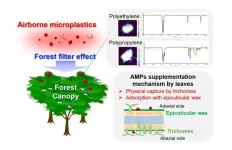Treatment of advanced non-small cell lung cancer with driver mutations
2024-03-27
(Press-News.org)
Lung cancer is the leading cause of cancer-related death worldwide. Improved understanding of driver mutations of non-small cell lung cancer (NSCLC) has led to more biomarker-directed treatment for patients with advanced stages. The expanding number of drugs targeting these driver mutations offers more opportunity to improve patient’s survival benefit.
To date, NSCLCs, especially those with non-squamous histology, are recommended for testing epidermal growth factor receptor (EGFR) mutations, anaplastic lymphoma kinase (ALK) gene rearrangements, ROS proto-oncogene receptor tyrosine kinase 1 (ROS-1) rearrangements, B-raf proto-oncogene (BRAF) mutations, rearranged during transfection (RET) fusions, Met proto-oncogene (MET) amplification and exon 14 skipping alterations, neurotrophic receptor tyrosine kinase (NTRK) gene fusions, and immunohistochemistry (IHC) testing for the programmed death receptor-ligand 1 (PD-L1) expression.
EGFR-activating mutations are the most common driver mutations in NSCLC. Targeted therapies included first-generation epidermal growth factor inhibitor tyrosine kinase inhibitors (EGFR-TKIs), erlotinib, gefitinib, and icotinib; second-generation pan-human epidermal growth receptor (HER) family inhibitor, afatinib and dacotinib; and third-generation EGFR-TKI, osimertinib, that inhibits both EGFR-sensitive mutations and resistant mutation EGFR T790M. ALK inhibitors included first-generation, crizotinib; second generation, ceritinib, alectinib, and brigatinib; and third-generation, lorlatinib, with increasing capacity for ALK inhibition generation-by-generation. The resistance caused by secondary ALK mutations can be overcome by next-generation ALK-TKIs. Moreover, alectinib, brigatinib, and lorlatinib are all recommended as first-line treatment choice for ALK-rearranged NSCLC for their superior survival compared with crizontinb. Crizotinib, ceritinib, brigatinib, and lorlatinib can also inhibit ROS-1. BRAF inhibitor dabrafenib combined with MEK inhibitor trametinib is now the recommended treatment for BRAF V600E-mutated NSCLC attributing to improved outcomes compared with vemurafenib or dabrafenib monotherapy. Drugs targeting MET aberrations with different binding modes included type Ia, crizotinib; type Ib, tepotinib, capmatinib, and savolitinib; and type II, cabozantinib. Entrectinib and larotrectinib are the current standard treatment for NTRK fusion-positive NSCLC. Kirsten ratsarcoma viral oncogene homolog (KRAS) mutations occur in ~20%–30% of patients with NSCLC. Recently, several small molecules including sotorasib (AMG510), adagrasib (MRTX-849) have been developed to specifically target KRAS G12C.
Although drugs targeting oncogenic driver mutations have significantly improved survival but their long-term responses are still uncommon for most patients, the emergence of acquired drug resistance is inevitable. Therefore, exploration and understanding of the resistance mechanism of target therapy are important to enhance the clinical outcomes and ultimately increase the treatment rate of NSCLC. Meanwhile, improved understanding of biological characteristics in various molecular subtypes of each driver mutation helps explore new classified treatment strategies. Until recently, multiomics analysis has ushered in a new era of precision targeted therapy in lung cancer and led to a deeper understanding of the underlying resistant mechanism. All these scientific and clinical progresses ultimately lead to improved survival in NSCLC and achieve more refined individualized treatment.
The discovery of oncogenic driver alterations and target therapy have brought significant clinical benefits and established an individualized treatment approach. The management of advanced NSCLC has shifted from a histology based on a biomarker-driven process.
The treatment landscape of oncogenic-addicted NSCLC has become complex. On the one hand, more individualized treatment based on fine stratification has become the focus of research nowadays. The choice of optimal treatment strategy should consider gene subtype, concomitant mutation, dynamic gene alternation, and metastasis site. On the other hand, understanding primary and acquired resistance to targeted therapy provides an insight into the molecular evolution of tumor development. The recognition of resistant mechanisms is the basis to design new drugs or combinatorial therapeutic strategies.
Combination strategies require integration with immunotherapy, and the immunosuppressive microenvironment should be reversed to improve the sensitivity of ICIs by the drug combination. We should also be aware of the possible risk of combined toxicity and thereby explore the optimal timing and combined regimen of immunotherapy. Meanwhile, the interaction between driver mutations and immune-microenvironment is essential to uncover after drug resistance and to establish robust predictive biomarker for the NSCLC with driver mutations, in order to identify specific oncogenic driving patients with NSCLC who can benefit from immunotherapy.
END
ELSE PRESS RELEASES FROM THIS DATE:
2024-03-27
Rabbits are popular family pets, with around 1.5 million* in the UK and it is important that owners can recognise when their animal is in pain, and know when to seek help to protect their rabbit’s welfare. New research by the University of Bristol Veterinary School has found the majority of rabbit owners could list signs of pain and could mostly identify pain-free rabbits and those in severe pain, but many lacked knowledge of the subtler sign of pain.
The study, published in BMC Veterinary Research today [27 March], provides the first insight into how rabbit owners identify pain and their general ability to apply this knowledge to detect pain ...
2024-03-27
A research group led by Japan Women’s University finds that airborne microplastics adsorb to the epicuticular wax on the surface of forest canopy leaves, and that forests may act as terrestrial sinks for airborne microplastics
Tokyo, Japan – Think of microplastics, and you might think of the ones accumulating in the world’s oceans. However, they are also filling the sky and the air we breathe. Now, it has been discovered that forests might be acting as a sink for these airborne microplastics, offering humanity yet another ...
2024-03-27
The world-leading Dunedin Study is set to launch its age 52 assessments, delving into an understudied but important period of life and time of change.
The Dunedin Multidisciplinary Health and Development Study is a longitudinal study that follows the lives of 1037 babies born in Queen Mary Maternity Hospital between 1 April 1972 and 31 March 1973. It is the most detailed study of human health and development in the world.
Members have been assessed regularly throughout their lives, most recently at age 45.
Study Director, Research Professor Moana Theodore is incredibly excited ...
2024-03-27
An opportunistic emergency department stop smoking prompt, comprising brief advice by a trained professional, an e-cigarette starter kit, and referral to local stop smoking services can help smokers quit, with a significant proportion of them still not smoking 6 months later, finds research published online in Emergency Medicine Journal.
Some 6.4 million people in the UK still haven’t stubbed out for good, and of the large numbers of people attending emergency departments, a substantial proportion are more likely to be smokers and have poorer overall health, explain ...
2024-03-27
Consistently exercising 2-3 times a week over the long term is linked to a lower current risk of insomnia as well as the ability to clock up the recommended 6-9 hours of shut eye every night, suggests an international 10-year study published in the open access journal BMJ Open.
Regular exercise is associated with better overall health, and several studies have suggested that physical activity promotes better quality sleep and may improve symptoms of chronic insomnia, note the researchers.
But it’s not entirely clear how much gender, age, weight (BMI), overall fitness, general health and exercise ...
2024-03-27
Peer reviewed – randomised controlled trial - humans
Giving out free e-cigarette starter packs in hospital emergency departments to people who smoke helps more people quit – according to research from the University of East Anglia.
The trial, funded by the National Institute for Health and Care Research (NIHR), offered advice, an e-cigarette starter pack and referral to stop smoking services to people attending A&E for any reason, to help them to stop smoking.
Six months later, almost one in four people given the starter packs said they had quit smoking. And those who received ...
2024-03-27
Implementing a single shared digital prescribing record across the NHS in England could avoid nearly 1 million drug errors every year, stopping up to 16,000 fewer patients from being harmed, and saving up to 22 lives every year, suggests a modelling study, published online in BMJ Quality & Safety.
The figures, which are based on the assumption that such a system could reduce medication errors by at least 10%, and by as much as 50%, could also save £millions for the NHS, say the researchers.
Previously published research suggests that drug errors cost the NHS £98 ...
2024-03-26
Using novel machine learning tools developed at Stanford Medicine, researchers have mapped three distinct cellular configurations that correspond to clinical outcomes for patients with a rare, difficult-to-treat cancer called soft tissue sarcoma.
In particular, the technique identified a cellular neighborhood that correlated with a positive response to immunotherapy, which may help physicians make treatment decisions.
“These cancers are challenging,” said Everett Moding, MD, PhD, an assistant professor of radiation oncology. “Up to half of patients diagnosed with a primary tumor will develop distant metastases, but we don’t have a good way to predict ...
2024-03-26
A team of researchers from Columbia University Irving Medical Center (CUIMC) and Columbia Engineering has been awarded up to a $38.95 million contract from the Advanced Research Projects Agency for Health (ARPA-H) to build a living knee replacement from biomaterials and human stem cells, including a patient’s own cells. ARPA-H is a federal funding agency that funds transformative biomedical and health research breakthroughs, rapidly translating research from the lab to applications in the marketplace.
The Award
The award, part of the ARPA-H’s Novel Innovations for Tissue Regeneration ...
2024-03-26
Take a puff of nicotine for the first time, and your DNA plays an important role, alongside social and environmental factors, in shaping what happens next.
In recent years, scientists have identified thousands of genetic variants believed to influence everything from when people first try smoking to how good that first cigarette feels to how often they light up and how hard it is to quit. Some variants influence how quickly we metabolize nicotine, while others underlie how sensitive we are to it. But little is known about how they interact with each other and with other genetic differences.
A new University of Colorado Boulder study sheds unprecedented ...
LAST 30 PRESS RELEASES:
[Press-News.org] Treatment of advanced non-small cell lung cancer with driver mutations


